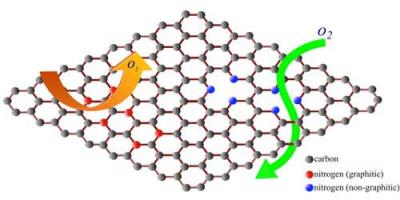Researchers from the Clemson Nanomaterials Institute and the Ural Federal University in Russia have discovered a way to make an extremely thin oxygen selective membrane using graphene. Such membranes allow only oxygen into Li-O2 batteries while stopping or slowing water vapor intake. This could impede corrosion caused by ambient water vapor from air and push forward the usability of much-awaited Li-O2 batteries in electric vehicles and more.

The team has developed an in situ technique to induce pores in graphene by doping it with nitrogen during the growth process. Doping the graphene sheet with nitrogen inevitably breaks some carbon bonds in graphene, opening nanoscopic pores. The researchers observed that such pores in doped graphene selectively allow oxygen, leading to oxidation of the underlying copper foil, unlike pristine graphene.
"Conventional protective membrane coatings are usually few microns thick. On the other hand, graphene coatings are extremely thin and yet robust," notes the team. "We hope to enable new applications such as Li-O2 batteries using graphene-based oxygen selective membranes". The team stated that it ultimately wishes to induce pores of different configurations to selectively filter ions, molecules and gases. "To this end, we are now exploring other dopants such as boron for in situ engineering of the pores to filter specific gases."
Membranes are a promising research area for graphene, and recent advances include Manchester U's graphene oxide membranes for water desalination and China-based FiiO Electronics' new in-ear monitor earphones, the FiiO F3, that make use of a graphene-enhanced diaphragm driver.



